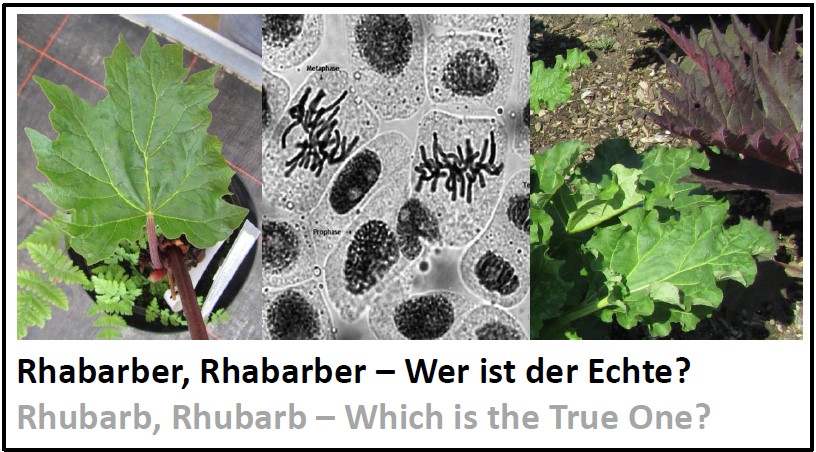 Plant Evolution 2023
Plant Evolution 2023
The Rhubarbs are a very young genus that has been born only around 6 million years ago, when the Tibetian plateau was formed. They have a long tradition in Traditional Chinese Medicine (TCM) and are also commercialised in Europe as phytopharmaceutica. However, the Chinese tradition distinguishes two types of medicinal Rhubarb, for good reasons. The so called Ta-Huang is used to cure gastrointestinal diseases and contains emodin as active compound. Instead, T’u Ta-Huang is not used for this purpose, because it contains rhaponticin, which acts as a phytoestrogene. However, this type of Rhubarb has potential to alleviate difficulties in the female menopause. Unfortunately, the nomenclature of Rhubarbs is a complete mess, and the market is flooded with wrongly declared products. Using genetic barcoding, we have tried to sort this out. It turns out that some "species" such as Rheum officinalis, are not a real species, but derive from different origins. On the other hand, the true Rheum rhaponticum, which is interesting as source for rhaponticine, cannot be clearly delineated from Rheum rhabarbarum, which is widely used for food purposes. These two species are overlapping, because Rheum rhabarbarum originated from R. rhaponticum by allopolyploidy, which means, it has twice the numbrer of chromosomes. Thus, the project explores the possibility to discern the two species by karyocytology - meristematic cells in the root tip are prepared to visualised the chromosomes, such that in the metaphase plate the ploidy can be explored. Moreover, using our Rhubarb collection, the potential parent of R. rhabarbarum is assessed (plastidic markers are only inherited from the mother). Manuscript with figures on Rhubarb identification (unpublished) is deposited on Ilias. Wober et al. 2007 on the mode of action of rhaponticine.
Genetic Barcoding
How do we proceed?
First, we invest quite some effort into the authenticity of our reference plants that cultivated in the Botanical Garden and are verified by classical taxonomical determination. The quality of a method stands or falls with the authenticity of the reference plant. Therefore, all our plants carry an ID that never changes, even when the name of the plant changes (which is not a rare event - first, plant taxonomy is continuously reformed, such that names can change, second, an estimated 10-20% of entries in Botanical Gardens or gene banks are wrongly determined or named, such that often the plants, we get from other gardens, turn out to be something else after our identification). In the second step, databases are screened for presence of suitable genetic barcodes - the more markers are available, the informative they are, the better for the security of our results. We then isolate genomic DNA from the references and amplify the respective barcoding marker by PCR to obtain the sequence for later analysis. In parallel, the accessions are microscopically compared - interesting diagnostic markers are, for instance, stomatal patterns, the relation between pavement cells and palisade parenchyma, but also hairs, trichomes, or crystals. When the sequences arrive, they are aligned with sequences from the data base and used to construct a molecular phylogeny (neighbor-joining). Suitable sequence differences are then used as base to develop a diagnostic test - for instance, by RFLP or ARMS.
Examples
- Project Bamboo as Novel Food. more...
- Project Deathly Bear Leek. more...
- Project TCM-Goji Berry. more...
- Project TCM-Allium fistulosum. more...
Publications
169. Ríos Rodríguez D, Sahi VP, Nick P (2021) Authentication of Holy Basil using Markers Relating to a Toxicology-Relevant Compound. Eur Food Res Technol 247, 2485-2497 - pdf
[50] Ichim MC, Häser A, Nick P (2020) Microscopic Authentication of Commercial Herbal Products in the Globalized Market: Potential and Limitations. Front Pharmacol 11, 876 - pdf
140. Wetters S, Nick P, Horn T (2018) Goji Who? Morphological and DNA based Authentication of a „Superfood”. Frontiers Plant Science 9, 1859 - pdf
[44] Nick P (2018) Pflanzliche „Superfoods“ – Verbraucherschutz versus Globalisierung. Lebensmittel und Recht 6, 228-232 - pdf
138. Jürges J, Sahi V, Rios D, Reich E, Bhamra S, Howard C, Slater A, Nick P (2018) Product Authenticity versus Globalisation - The Tulsi Case. PloS ONE 13, e0207763 - pdf
102. Horn T, Völker J, Rühle M, Häser A, Jürges G, Nick P (2014) Genetic authentication by RFLP versus ARMS? The case of Moldavian Dragonhead (Dracocephalum moldavica L.). Eur Food Sci Technol 238, 93-104 - pdf
90. Horn T, Barth A, Rühle M, Häser A, Jürges G, Nick P (2012) Molecular Diagnostics of Lemon Myrtle (Backhousia citriodora versus Leptospermum citratum). Eur Food Res Technol 234, 853-861 - pdf
